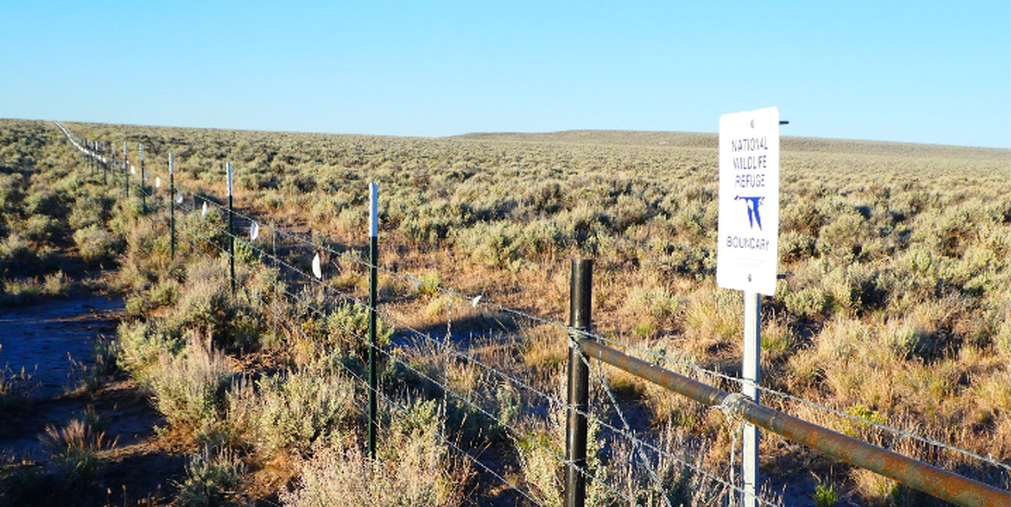Surveying the Boundary Fence
While it might seem curious that a wildlife refuge of more than 270,000 acres would need a boundary fence, the enclosure is critical to the preservation of the integrity of the Hart Mountain National Antelope Refuge. Without it, rangeland crucial to sustaining the refuge’s Pronghorn population would be open to depredation by domestic cattle and wild horses. To protect this land, in recent years a new fence has been constructed. It is not enough simply to build the fence, however. It must also be maintained to ensure that it can withstand the challenges of winter storms, summer fires and the occasional vandal. This requires periodic surveys of nearly 100 miles of fence to ensure the four strands of wire are remaining taut.
A refuge fence can be a bit different from the normal agricultural fence. The Hart Mountain boundary fence is constructed of steel T-bar posts and consists of four strands of wire. The top three are barbed wire and the bottom strand is smooth. The reason for the smooth wire is that pronghorn generally prefer to crawl under a fence to jumping it. For that reason too, the bottom wire must now be 20” above the ground.
In the days of tight budgets and short staffs, finding people to survey the fences has required turning to volunteers. This year members of the Friends of Hart Mountain have stepped forward to check fence on the east, southeast, south, and west boundaries of the refuge.
Because of the terrain, patrolling the fence requires using an ATV and walking. Member John Geller surveyed the east boundary, where the only road was a mere track that has left his kidneys aching. Where the ATV could not go, John walked—four and a half miles. Member Bill Crowell took his ATV down the refuge past the Calderwood homestead to the south boundary fence at Lake Wool, where it was suspected a cow had gotten through. But a hoof print was the only sign of a cow, and the fence was intact. The following day, Bill and a refuge staff member checked the fence on the West side from the Hart road to the southeast corner of the refuge. They found one spot where someone apparently had cut an opening in the fence and then spliced it closed using a section of the bottom wire.
While the riding was rough and the walking, not much easier, the opportunity to view far corners of the refuge repaid the effort. John was impressed by stunning views of Beatys Butte and Guano Canyon. The views along the road his second day were of some of the nicest terrain on the refuge, including undulating landscape, dry lake beds filled with grass, juniper stands and grand views in all directions. Both men are looking forward to the next opportunity to survey the fence.
A refuge fence can be a bit different from the normal agricultural fence. The Hart Mountain boundary fence is constructed of steel T-bar posts and consists of four strands of wire. The top three are barbed wire and the bottom strand is smooth. The reason for the smooth wire is that pronghorn generally prefer to crawl under a fence to jumping it. For that reason too, the bottom wire must now be 20” above the ground.
In the days of tight budgets and short staffs, finding people to survey the fences has required turning to volunteers. This year members of the Friends of Hart Mountain have stepped forward to check fence on the east, southeast, south, and west boundaries of the refuge.
Because of the terrain, patrolling the fence requires using an ATV and walking. Member John Geller surveyed the east boundary, where the only road was a mere track that has left his kidneys aching. Where the ATV could not go, John walked—four and a half miles. Member Bill Crowell took his ATV down the refuge past the Calderwood homestead to the south boundary fence at Lake Wool, where it was suspected a cow had gotten through. But a hoof print was the only sign of a cow, and the fence was intact. The following day, Bill and a refuge staff member checked the fence on the West side from the Hart road to the southeast corner of the refuge. They found one spot where someone apparently had cut an opening in the fence and then spliced it closed using a section of the bottom wire.
While the riding was rough and the walking, not much easier, the opportunity to view far corners of the refuge repaid the effort. John was impressed by stunning views of Beatys Butte and Guano Canyon. The views along the road his second day were of some of the nicest terrain on the refuge, including undulating landscape, dry lake beds filled with grass, juniper stands and grand views in all directions. Both men are looking forward to the next opportunity to survey the fence.

